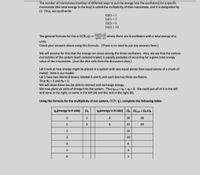
Introductory Circuit Analysis (13th Edition)
13th Edition
ISBN: 9780133923605
Author: Robert L. Boylestad
Publisher: PEARSON
expand_more
expand_more
format_list_bulleted
Concept explainers
Question
Please fill the table and get the thumbs up in half hour

Transcribed Image Text:The number of microstates (number of different ways to put the energy into the oscillators) for a specific
macrostate (the total energy in the box) is called the multiplicity of that macrostate, and it is designated by
Q. Thus, we could write
2(0) = 1
Q(1) = 3
2(2) = 6
2(3) = 10.
The general formula for this is 2(N, q)
(q+N-1)!
q!(N-1)!
where there are N oscillators with a total energy of q
%3D
units.
Check your answers above using this formula. (There is no need to put any answers here.)
We will assume for this that the energy can move among the three oscillators. Also, we say that the various
microstates of the system (each ordered triplet) is equally probable of occurring for a given total energy
value of the macrostate. (Just like dice rolls from the discussion class.)
Let's look at how energy might be placed in a system with two equal pieces (two equal pieces of a chunk of
metal). Here is our model:
Let's have two identical boxes, labeled A and B, and each box has three oscillators.
Thus NA = 3 and Ns = 3.
We will allow these box be able to interact and exchange energy.
We now place six units of energy into the system. Thus qtotal = qa + qe = 6. We could put all of it in the left
and none in the right, or some in the left (A) and the rest in the right (B).
Using the formula for the multiplicity of our system, N(N,q), complete the following table:
qa(energy in A side)
qolenergy in B side) 2 total = a
1
28
28
1
3
21
63
15
3
10
4
6
5
3
Expert Solution
This question has been solved!
Explore an expertly crafted, step-by-step solution for a thorough understanding of key concepts.
Step by stepSolved in 4 steps

Knowledge Booster
Learn more about
Need a deep-dive on the concept behind this application? Look no further. Learn more about this topic, electrical-engineering and related others by exploring similar questions and additional content below.Similar questions
- i need the answer quicklyarrow_forwardRepeat above (insert image) with the resistors in parallel, insert multitesters (digital or analog) to measure current along each resistor. Comment on the meter readings and set up.arrow_forwardAndrew Foods, Inc., produces a sweet syrup made from corn syrup and beet syrup mixed with pure sugar. For each batch, 680 lbm of beet syrup (13% sugar, the remainder water) and 650 lbm of corn syrup (8.0% sugar, the remainder water) are mixed with pure sugar and 350 lbm of water is boiled off. Determine the amount of pure sugar that needs to be added to produce an 18% sugar content in the final product.arrow_forward
arrow_back_ios
arrow_forward_ios
Recommended textbooks for you
 Introductory Circuit Analysis (13th Edition)Electrical EngineeringISBN:9780133923605Author:Robert L. BoylestadPublisher:PEARSON
Introductory Circuit Analysis (13th Edition)Electrical EngineeringISBN:9780133923605Author:Robert L. BoylestadPublisher:PEARSON Delmar's Standard Textbook Of ElectricityElectrical EngineeringISBN:9781337900348Author:Stephen L. HermanPublisher:Cengage Learning
Delmar's Standard Textbook Of ElectricityElectrical EngineeringISBN:9781337900348Author:Stephen L. HermanPublisher:Cengage Learning Programmable Logic ControllersElectrical EngineeringISBN:9780073373843Author:Frank D. PetruzellaPublisher:McGraw-Hill Education
Programmable Logic ControllersElectrical EngineeringISBN:9780073373843Author:Frank D. PetruzellaPublisher:McGraw-Hill Education Fundamentals of Electric CircuitsElectrical EngineeringISBN:9780078028229Author:Charles K Alexander, Matthew SadikuPublisher:McGraw-Hill Education
Fundamentals of Electric CircuitsElectrical EngineeringISBN:9780078028229Author:Charles K Alexander, Matthew SadikuPublisher:McGraw-Hill Education Electric Circuits. (11th Edition)Electrical EngineeringISBN:9780134746968Author:James W. Nilsson, Susan RiedelPublisher:PEARSON
Electric Circuits. (11th Edition)Electrical EngineeringISBN:9780134746968Author:James W. Nilsson, Susan RiedelPublisher:PEARSON Engineering ElectromagneticsElectrical EngineeringISBN:9780078028151Author:Hayt, William H. (william Hart), Jr, BUCK, John A.Publisher:Mcgraw-hill Education,
Engineering ElectromagneticsElectrical EngineeringISBN:9780078028151Author:Hayt, William H. (william Hart), Jr, BUCK, John A.Publisher:Mcgraw-hill Education,

Introductory Circuit Analysis (13th Edition)
Electrical Engineering
ISBN:9780133923605
Author:Robert L. Boylestad
Publisher:PEARSON

Delmar's Standard Textbook Of Electricity
Electrical Engineering
ISBN:9781337900348
Author:Stephen L. Herman
Publisher:Cengage Learning

Programmable Logic Controllers
Electrical Engineering
ISBN:9780073373843
Author:Frank D. Petruzella
Publisher:McGraw-Hill Education

Fundamentals of Electric Circuits
Electrical Engineering
ISBN:9780078028229
Author:Charles K Alexander, Matthew Sadiku
Publisher:McGraw-Hill Education

Electric Circuits. (11th Edition)
Electrical Engineering
ISBN:9780134746968
Author:James W. Nilsson, Susan Riedel
Publisher:PEARSON

Engineering Electromagnetics
Electrical Engineering
ISBN:9780078028151
Author:Hayt, William H. (william Hart), Jr, BUCK, John A.
Publisher:Mcgraw-hill Education,